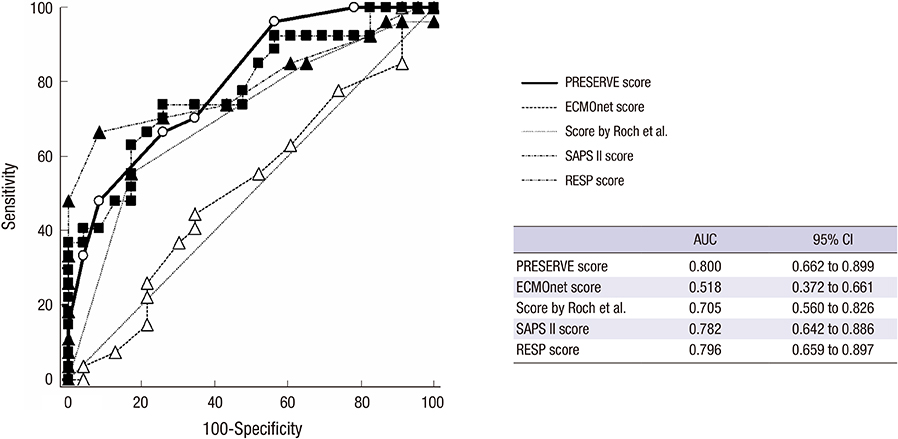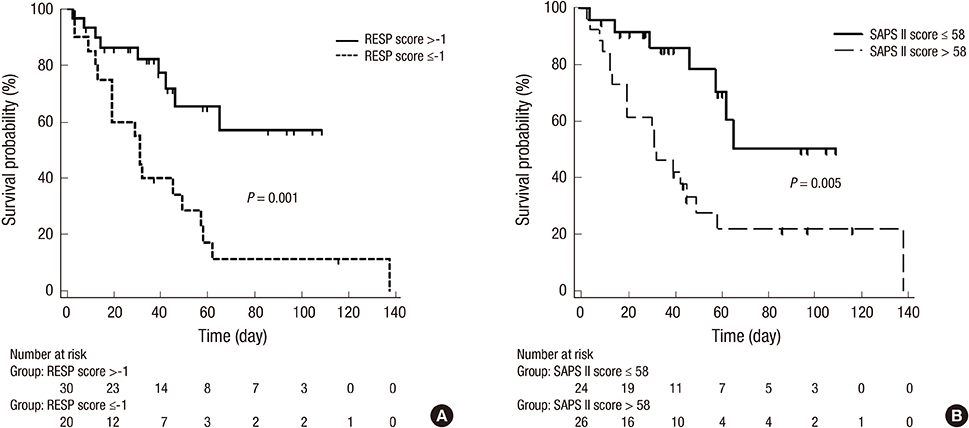J Korean Med Sci.
2016 Jun;31(6):932-938. 10.3346/jkms.2016.31.6.932.
Validity of Outcome Prediction Scoring Systems in Korean Patients with Severe Adult Respiratory Distress Syndrome Receiving Extracorporeal Membrane Oxygenation Therapy
- Affiliations
-
- 1Department of Internal Medicine, Pusan National University Yangsan Hospital, Yangsan, Korea. popeyes0212@hanmail.net
- 2Department of Cardiovascular and Thoracic Surgery, Pusan National University Yangsan Hospital, Yangsan, Korea.
- KMID: 2373703
- DOI: http://doi.org/10.3346/jkms.2016.31.6.932
Abstract
- Recently, several prognostic scoring systems for patients with severe acute respiratory distress syndrome (ARDS) requiring extracorporeal membrane oxygenation (ECMO) have been published. The aim of this study was to validate the established scoring systems for outcome prediction in Korean patients. We retrospectively reviewed the data of 50 patients on ECMO therapy in our center from 2012 to 2014. A calculation of outcome prediction scoring tools was performed and the comparison across various models was conducted. In our study, the overall hospital survival was 46% and successful weaning rate was 58%. The Predicting Death for Severe ARDS on V-V ECMO (PRESERVE) score showed good discrimination of mortality prediction for patients on ECMO with AUC of 0.80 (95% CI 0.66-0.90). The respiratory extracorporeal membrane oxygenation survival prediction (RESP) score and simplified acute physiology score (SAPS) II score also showed fair prediction ability with AUC of 0.79 (95% CI 0.65-0.89) and AUC of 0.78 (95% CI 0.64-0.88), respectively. However, the ECMOnet score failed to predict mortality with AUC of 0.51 (95% CI 0.37-0.66). When evaluating the predictive accuracy according to optimal cut-off point of each scoring system, RESP score had a best specificity of 91.3% and 66.7% of sensitivity, respectively. This study supports the clinical usefulness of the prognostic scoring tools for severe ARDS with ECMO therapy when applying to the Korean patients receiving ECMO.
Keyword
MeSH Terms
Figure
Cited by 1 articles
-
Usefulness of the RESP, PRESERVE, and ECMOnet scores for extracorporeal membrane oxygenation in children with acute respiratory distress syndrome
Won Kee Ahn, Jung Ho Han, Yoon Hee Kim, In Suk Sol, Seo Hee Yoon, Min Jung Kim, Kyung Won Kim, Myung Hyun Sohn, Kyu-Earn Kim
Allergy Asthma Respir Dis. 2017;5(3):141-146. doi: 10.4168/aard.2017.5.3.141.
Reference
-
1. Pham T, Combes A, Rozé H, Chevret S, Mercat A, Roch A, Mourvillier B, Ara-Somohano C, Bastien O, Zogheib E, et al. Extracorporeal membrane oxygenation for pandemic influenza A(H1N1)-induced acute respiratory distress syndrome: a cohort study and propensity-matched analysis. Am J Respir Crit Care Med. 2013; 187:276–285.2. Schmidt M, Zogheib E, Rozé H, Repesse X, Lebreton G, Luyt CE, Trouillet JL, Bréchot N, Nieszkowska A, Dupont H, et al. The PRESERVE mortality risk score and analysis of long-term outcomes after extracorporeal membrane oxygenation for severe acute respiratory distress syndrome. Intensive Care Med. 2013; 39:1704–1713.3. Pappalardo F, Pieri M, Greco T, Patroniti N, Pesenti A, Arcadipane A, Ranieri VM, Gattinoni L, Landoni G, Holzgraefe B, et al. Predicting mortality risk in patients undergoing venovenous ECMO for ARDS due to influenza A (H1N1) pneumonia: the ECMOnet score. Intensive Care Med. 2013; 39:275–281.4. Schmidt M, Bailey M, Sheldrake J, Hodgson C, Aubron C, Rycus PT, Scheinkestel C, Cooper DJ, Brodie D, Pellegrino V, et al. Predicting survival after extracorporeal membrane oxygenation for severe acute respiratory failure. The Respiratory Extracorporeal Membrane Oxygenation Survival Prediction (RESP) score. Am J Respir Crit Care Med. 2014; 189:1374–1382.5. Roch A, Hraiech S, Masson E, Grisoli D, Forel JM, Boucekine M, Morera P, Guervilly C, Adda M, Dizier S, et al. Outcome of acute respiratory distress syndrome patients treated with extracorporeal membrane oxygenation and brought to a referral center. Intensive Care Med. 2014; 40:74–83.6. Enger T, Philipp A, Videm V, Lubnow M, Wahba A, Fischer M, Schmid C, Bein T, Müller T. Prediction of mortality in adult patients with severe acute lung failure receiving veno-venous extracorporeal membrane oxygenation: a prospective observational study. Crit Care. 2014; 18:R67.7. Extracorporeal Life Support Organization (US). ELSO guidelines for adult respiratory failure v1.3 (ELSO adult respiratory failure supplement to the ELSO general guidelines) [Internet]. accessed on 1 May 2015. Available at http://www.elso.org/Resources/Guidelines.aspx.8. The Acute Respiratory Distress Syndrome Network. Ventilation with lower tidal volumes as compared with traditional tidal volumes for acute lung injury and the acute respiratory distress syndrome. N Engl J Med. 2000; 342:1301–1308.9. Extracorporeal Life Support Organization (US). ELSO guidelines general v1.3 (general guidelines for all ECLS cases) [Internet]. accessed on 1 May 2015. Available at http://www.elso.org/Resources/Guidelines.aspx.10. Kohler K, Valchanov K, Nias G, Vuylsteke A. ECMO cannula review. Perfusion. 2013; 28:114–124.11. Alhazzani W, Alshahrani M, Jaeschke R, Forel JM, Papazian L, Sevransky J, Meade MO. Neuromuscular blocking agents in acute respiratory distress syndrome: a systematic review and meta-analysis of randomized controlled trials. Crit Care. 2013; 17:R43.12. Peek GJ, Mugford M, Tiruvoipati R, Wilson A, Allen E, Thalanany MM, Hibbert CL, Truesdale A, Clemens F, Cooper N, et al. Efficacy and economic assessment of conventional ventilatory support versus extracorporeal membrane oxygenation for severe adult respiratory failure (CESAR): a multicentre randomised controlled trial. Lancet. 2009; 374:1351–1363.13. Brogan TV, Thiagarajan RR, Rycus PT, Bartlett RH, Bratton SL. Extracorporeal membrane oxygenation in adults with severe respiratory failure: a multi-center database. Intensive Care Med. 2009; 35:2105–2114.14. Klinzing S, Wenger U, Steiger P, Starck CT, Wilhelm M, Schuepbach RA, Maggiorini M. External validation of scores proposed for estimation of survival probability of patients with severe adult respiratory distress syndrome undergoing extracorporeal membrane oxygenation therapy: a retrospective study. Crit Care. 2015; 19:142.15. Le Gall JR, Loirat P, Alperovitch A. Simplified acute physiological score for intensive care patients. Lancet. 1983; 2:741.
- Full Text Links
- Actions
-
Cited
- CITED
-
- Close
- Share
- Similar articles
-
- Usefulness of the RESP, PRESERVE, and ECMOnet scores for extracorporeal membrane oxygenation in children with acute respiratory distress syndrome
- Erratum: Correction of Affiliations in the Article “Validity of Outcome Prediction Scoring Systems in Korean Patients with Severe Adult Respiratory Distress Syndrome Receiving Extracorporeal Membrane Oxygenation Therapy”
- The Treatment of Adult Respiratory Distress Syndrome (ARDS) Using Extracorporeal Membrane Oxygenation (ECMO)
- Recovery from Acute Respiratory Distress Syndrome with Long-Run Extracorporeal Membrane Oxygenation
- Successful use of extracorporeal membrane oxygenation for sudden aggravation of acute respiratory distress syndrome: A case report



